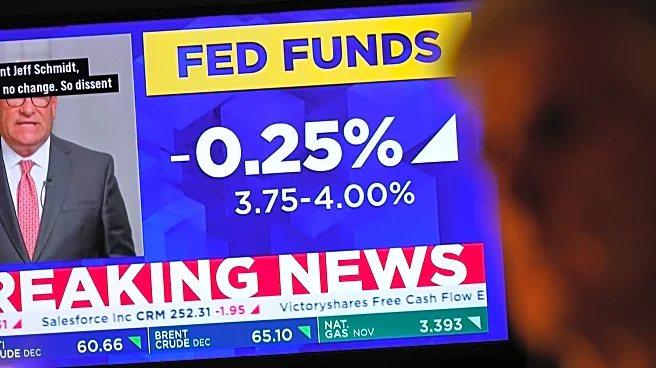What's Happening?
Gold prices have surged to a new record, with futures reaching around $3,750 and bullion trading above $3,700 per ounce. This marks a more than 40% increase year-to-date, making 2025 the best year for
gold since 1979. The rise is driven by expectations of a Federal Reserve easing cycle, which began with a 25 basis point interest rate cut and signals of further reductions. A weaker dollar has also contributed to the increase, as gold is priced in U.S. currency. Additionally, inflows into physically backed exchange-traded funds have hit a three-year high, and central banks continue to accumulate gold holdings.
Why It's Important?
The significant rise in gold prices reflects broader economic trends, including monetary policy shifts and currency fluctuations. As the Federal Reserve eases interest rates, the dollar weakens, making gold more attractive to investors. This trend impacts various stakeholders, including central banks, which are increasing gold reserves to hedge against currency risks. The surge in gold prices also highlights investor sentiment, with gold outperforming other assets like the S&P 500 and bitcoin. This shift indicates growing concerns about economic stability and inflation, prompting investors to seek safe-haven assets.
What's Next?
With the Federal Reserve signaling further interest rate cuts, gold prices may continue to rise, impacting investment strategies and central bank policies. Investors might increase their gold holdings, anticipating continued economic uncertainty. Central banks could further adjust their reserves to stabilize currencies, influencing global trade dynamics. Additionally, the ongoing geopolitical tensions and economic shifts may affect future gold price movements, as countries navigate trade relationships and monetary policies. The potential for gold to reach $4,000 per ounce by mid-2026, as predicted by analysts, suggests continued volatility in the market.
Beyond the Headlines
The current surge in gold prices underscores deeper economic challenges, including inflation and currency fluctuations. As countries address these issues, the role of gold as a stable investment becomes increasingly important. This situation highlights the need for strategic planning by investors and policymakers to manage potential long-term economic shifts. The historical context of gold prices reveals patterns that may guide future investment decisions, emphasizing the importance of understanding market dynamics and geopolitical influences.













